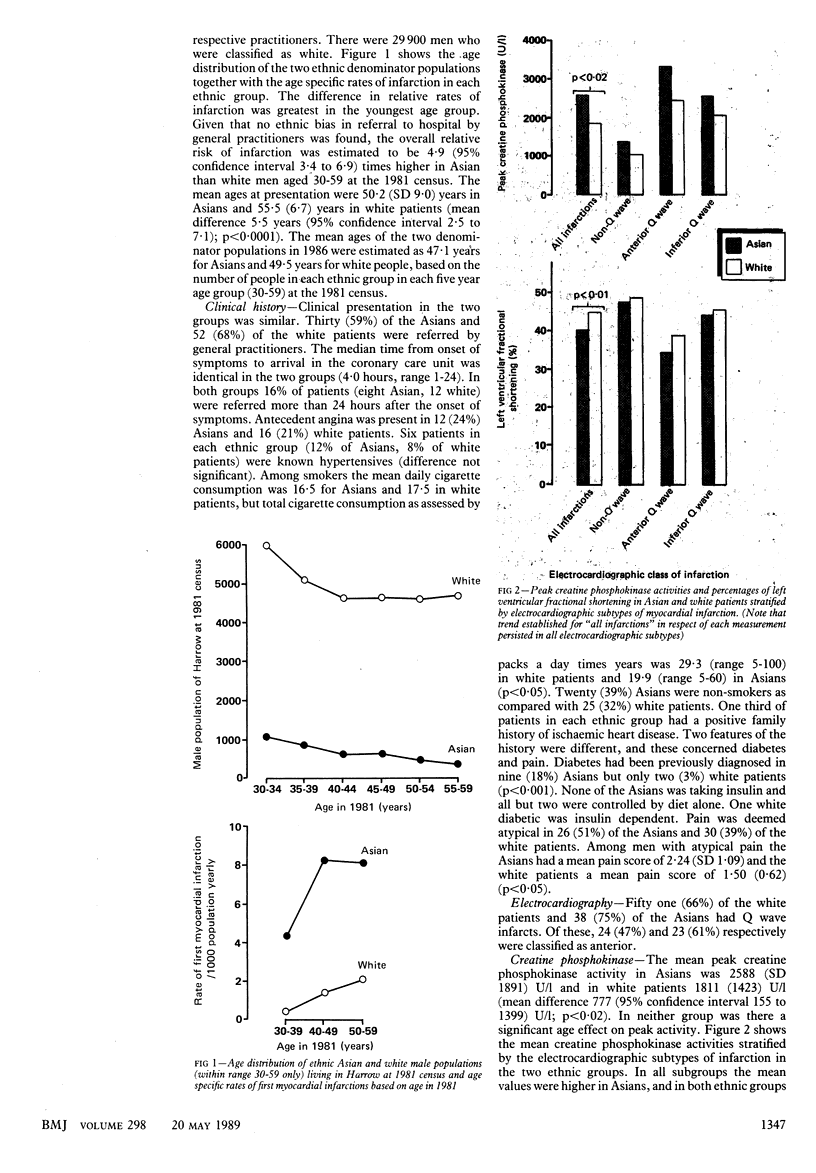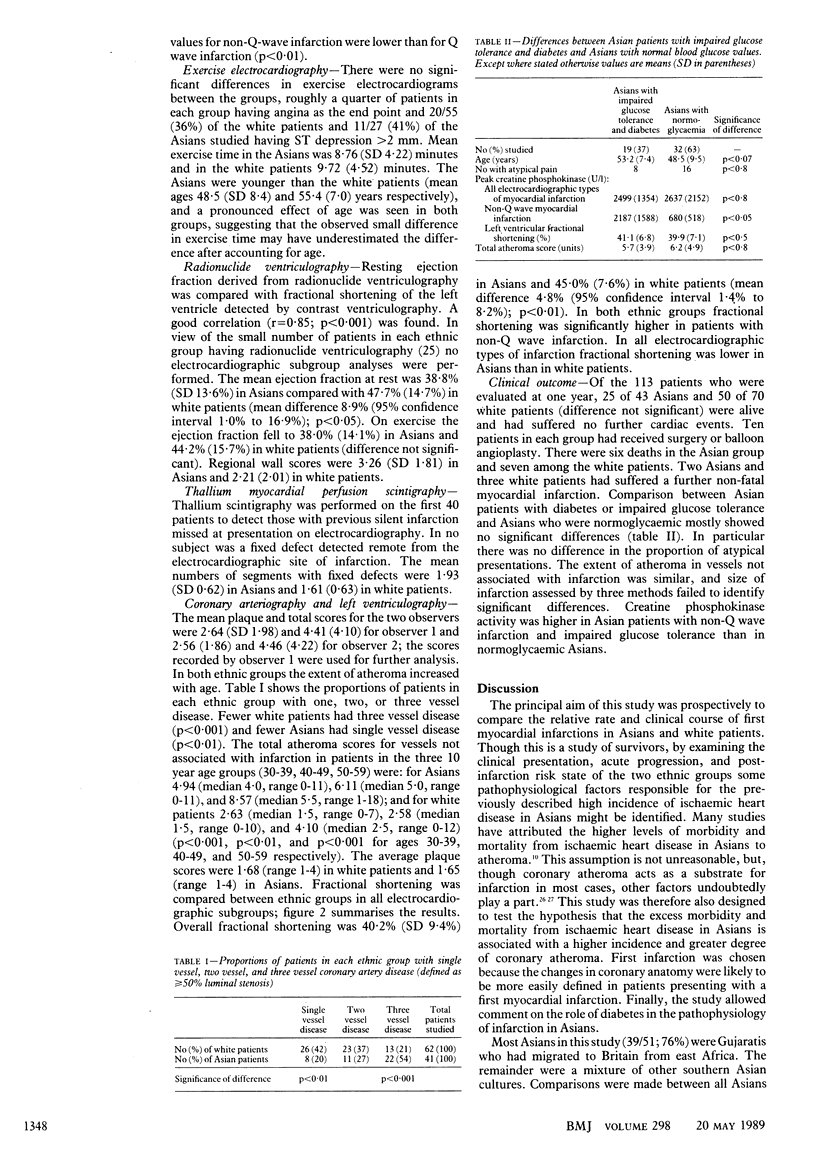Abstract
OBJECTIVE--To compare the presentation and natural course of first myocardial infarctions in immigrant Asians and the indigenous white population in Britain and the subsequent risk states of the two groups. DESIGN--Prospective ethnic comparison of consecutive patients with first myocardial infarctions. SETTING--Secondary referrals to a coronary care unit of a district general hospital. PATIENTS--128 Men (77 white, 54 Asian) presenting consecutively with a first myocardial infarction diagnosed on the basis of clinical, biochemical, and electrocardiographic findings. END POINT--Identification of mechanisms accounting for the increased rate of ischaemic heart disease in Asians. MEASUREMENTS AND MAIN RESULTS--Infarct size was assessed by measuring the release of creatine phosphokinase (all patients), radionuclide ventriculography (50), and contrast ventriculography (103). Risk states after infarction were assessed from the degree of ventricular dysfunction as determined by exercise electrocardiography (82 patients) and from the extent of coronary atheroma as determined by coronary arteriography (103). Glucose state was measured in fasting venous blood samples. Overall the relative rate of infarction was 4.9 times higher in Asians (95% confidence interval 3.4 to 6.9) than in the white population. Moreover, the relative rate of infarction was higher in Asians in all 10 year age groups, the greatest difference being in 30-39 year olds. The mean age of the Asian denominator population was 47.1 years compared with 49.5 years in the white population. Age at infarction was less in Asians (50.2 years) than in white patients (55.5 years; mean difference 5.5 years (95% confidence interval 2.5 to 7.1]. In Asians the mean creatine phosphokinase activity was 777 (95% confidence interval 155 to 1399) U/1 higher, radionuclide ejection fraction 8.9% (1.0% to 16.9%) lower, and left ventricular fractional shortening 4.8% (1.4% to 8.2%) lower than in white patients. The extent of coronary atheroma was significantly greater in Asians. The mean numbers of plaques in vessels not associated with infarction were 3.66 (median 3.0, range 0-10) in Asians compared with 1.97 (median 2.0, range 0-6) in white patients (p less than 0.001), and a higher proportion of Asians had three vessel coronary artery disease (p less than 0.001). Asians with diabetes or impaired glucose tolerance did not differ from those with normal blood glucose values. CONCLUSIONS--Atherogenesis arises earlier in Asians, contributing to premature first myocardial infarctions. The increased incidence of diabetes in Asians may not in itself be relevant in the greater propensity to coronary atheroma in Asians.
Full text
PDF





Selected References
These references are in PubMed. This may not be the complete list of references from this article.
- Balarajan R., Bulusu L., Adelstein A. M., Shukla V. Patterns of mortality among migrants to England and Wales from the Indian subcontinent. Br Med J (Clin Res Ed) 1984 Nov 3;289(6453):1185–1187. doi: 10.1136/bmj.289.6453.1185. [DOI] [PMC free article] [PubMed] [Google Scholar]
- Beckles G. L., Miller G. J., Kirkwood B. R., Alexis S. D., Carson D. C., Byam N. T. High total and cardiovascular disease mortality in adults of Indian descent in Trinidad, unexplained by major coronary risk factors. Lancet. 1986 Jun 7;1(8493):1298–1301. doi: 10.1016/s0140-6736(86)91221-3. [DOI] [PubMed] [Google Scholar]
- Bertrand M. E., Lefebvre J. M., Laisne C. L., Rousseau M. F., Carre A. G., Lekieffre J. P. Coronary arteriography in acute transmural myocardial infarction. Am Heart J. 1979 Jan;97(1):61–69. doi: 10.1016/0002-8703(79)90115-7. [DOI] [PubMed] [Google Scholar]
- Cabin H. S., Roberts W. C. Quantification of amounts of coronary arterial narrowing in patients with types II and IV hyperlipoproteinemia and in those with known normal lipoprotein patterns. Am Heart J. 1981 Jan;101(1):52–58. doi: 10.1016/0002-8703(81)90383-5. [DOI] [PubMed] [Google Scholar]
- Cruickshank J. K., Beevers D. G., Osbourne V. L., Haynes R. A., Corlett J. C., Selby S. Heart attack, stroke, diabetes, and hypertension in West Indians, Asians, and whites in Birmingham, England. Br Med J. 1980 Oct 25;281(6248):1108–1108. doi: 10.1136/bmj.281.6248.1108. [DOI] [PMC free article] [PubMed] [Google Scholar]
- Donaldson L. J., Taylor J. B. Patterns of Asian and non-Asian morbidity in hospitals. Br Med J (Clin Res Ed) 1983 Mar 19;286(6369):949–951. doi: 10.1136/bmj.286.6369.949. [DOI] [PMC free article] [PubMed] [Google Scholar]
- Hains A. D., Al-Khawaja I., Hinge D. A., Lahiri A., Raftery E. B. Radionuclide left ventricular ejection fraction: a comparison of three methods. Br Heart J. 1987 Mar;57(3):242–246. doi: 10.1136/hrt.57.3.242. [DOI] [PMC free article] [PubMed] [Google Scholar]
- Humphries J. O., Kuller L., Ross R. S., Friesinger G. C., Page E. E. Natural history of ischemic heart disease in relation to arteriographic findings: a twelve year study of 224 patients. Circulation. 1974 Mar;49(3):489–497. doi: 10.1161/01.cir.49.3.489. [DOI] [PubMed] [Google Scholar]
- Judkins M. P. Selective coronary arteriography. I. A percutaneous transfemoral technic. Radiology. 1967 Nov;89(5):815–824. doi: 10.1148/89.5.815. [DOI] [PubMed] [Google Scholar]
- Katz A. M., Messineo F. C. Lipid-membrane interactions and the pathogenesis of ischemic damage in the myocardium. Circ Res. 1981 Jan;48(1):1–16. doi: 10.1161/01.res.48.1.1. [DOI] [PubMed] [Google Scholar]
- Lahiri A., Rodrigues E. A., Al-Khawaja I., Raftery E. B. Effects of a new vasodilating beta-blocking drug, carvedilol, on left ventricular function in stable angina pectoris. Am J Cardiol. 1987 Apr 1;59(8):769–774. doi: 10.1016/0002-9149(87)91089-7. [DOI] [PubMed] [Google Scholar]
- Liedtke A. J., Nellis S., Neely J. R. Effects of excess free fatty acids on mechanical and metabolic function in normal and ischemic myocardium in swine. Circ Res. 1978 Oct;43(4):652–661. doi: 10.1161/01.res.43.4.652. [DOI] [PubMed] [Google Scholar]
- Lowry P. J., Glover D. R., Mace P. J., Littler W. A. Coronary artery disease in Asians in Birmingham. Br Heart J. 1984 Dec;52(6):610–613. doi: 10.1136/hrt.52.6.610. [DOI] [PMC free article] [PubMed] [Google Scholar]
- Maseri A., L'Abbate A., Baroldi G., Chierchia S., Marzilli M., Ballestra A. M., Severi S., Parodi O., Biagini A., Distante A. Coronary vasospasm as a possible cause of myocardial infarction. A conclusion derived from the study of "preinfarction" angina. N Engl J Med. 1978 Dec 7;299(23):1271–1277. doi: 10.1056/NEJM197812072992303. [DOI] [PubMed] [Google Scholar]
- Mather H. M., Keen H. The Southall Diabetes Survey: prevalence of known diabetes in Asians and Europeans. Br Med J (Clin Res Ed) 1985 Oct 19;291(6502):1081–1084. doi: 10.1136/bmj.291.6502.1081. [DOI] [PMC free article] [PubMed] [Google Scholar]
- McConahay D. R., McCallister B. D., Hallermann F. J., Smith R. E. Comparative quantitative analysis of the electrocardiogram and the vectorcardiogram. Correlations with the coronary arteriogram. Circulation. 1970 Aug;42(2):245–259. doi: 10.1161/01.cir.42.2.245. [DOI] [PubMed] [Google Scholar]
- Miller G. J., Beckles G. L., Alexis S. D., Byam N. T., Price S. G. Serum lipoproteins and susceptibility of men of Indian descent to coronary heart disease. The St James Survey, Trinidad. Lancet. 1982 Jul 24;2(8291):200–203. doi: 10.1016/s0140-6736(82)91041-8. [DOI] [PubMed] [Google Scholar]
- Morris J. A., Gardner M. J. Calculating confidence intervals for relative risks (odds ratios) and standardised ratios and rates. Br Med J (Clin Res Ed) 1988 May 7;296(6632):1313–1316. doi: 10.1136/bmj.296.6632.1313. [DOI] [PMC free article] [PubMed] [Google Scholar]
- O'Hara M. J., Lahiri A., Whittington J. R., Crawley J. C., Raftery E. B. Detection of high risk coronary artery disease by thallium imaging. Br Heart J. 1985 Jun;53(6):616–623. doi: 10.1136/hrt.53.6.616. [DOI] [PMC free article] [PubMed] [Google Scholar]
- Opie L. H. Metabolism of free fatty acids, glucose and catecholamines in acute myocardial infarction. Relation to myocardial ischemia and infarct size. Am J Cardiol. 1975 Dec;36(7):938–953. doi: 10.1016/0002-9149(75)90086-7. [DOI] [PubMed] [Google Scholar]
- Padhani A., Dandona P. Diabetes and coronary heart disease in north London Asians. Lancet. 1986 Jan 25;1(8474):213–214. doi: 10.1016/s0140-6736(86)90688-4. [DOI] [PubMed] [Google Scholar]
- Pedoe H. T., Clayton D., Morris J. N., Brigden W., McDonald L. Coronary heart-attacks in East London. Lancet. 1975 Nov 1;2(7940):833–838. doi: 10.1016/s0140-6736(75)90233-0. [DOI] [PubMed] [Google Scholar]
- Quinones M. A., Waggoner A. D., Reduto L. A., Nelson J. G., Young J. B., Winters W. L., Jr, Ribeiro L. G., Miller R. R. A new, simplified and accurate method for determining ejection fraction with two-dimensional echocardiography. Circulation. 1981 Oct;64(4):744–753. doi: 10.1161/01.cir.64.4.744. [DOI] [PubMed] [Google Scholar]
- SONES F. M., Jr, SHIREY E. K. Cine coronary arteriography. Mod Concepts Cardiovasc Dis. 1962 Jul;31:735–738. [PubMed] [Google Scholar]
- Subramanian V. B., Lahiri A., Paramasivan R., Raftery E. B. Verapamil in chronic stable angina. A controlled study with computerized multistage treadmill exercise. Lancet. 1980 Apr 19;1(8173):841–844. doi: 10.1016/s0140-6736(80)91351-3. [DOI] [PubMed] [Google Scholar]
- Thomas I., Gupta S., Sempos C., Cooper R. Serum lipids of Indian physicians living in the U.S. compared to U.S.-born physicians. Atherosclerosis. 1986 Aug;61(2):99–106. doi: 10.1016/0021-9150(86)90068-7. [DOI] [PubMed] [Google Scholar]


